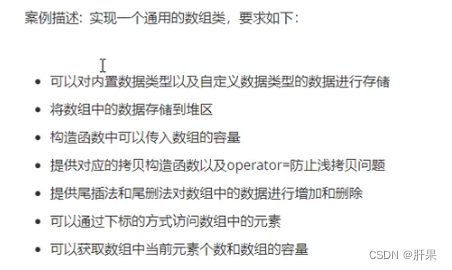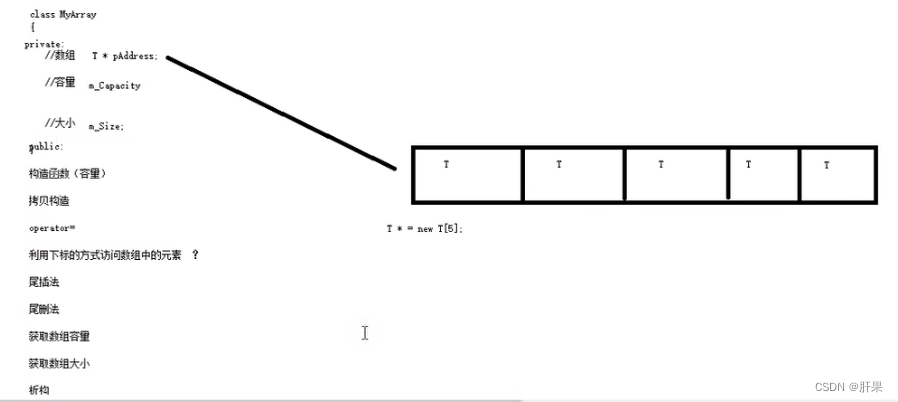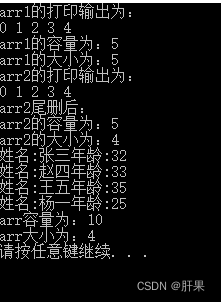类模板案例


main.cpp代码:
#include "myarray.hpp"
void printIntArray(MyArray <int>& arr)
{
for (int i = 0; i < arr.getSize(); ++i)
{
cout << arr[i] << " ";
}
cout << endl;
}
void test01()
{
MyArray <int>arr1(5);
for (int i = 0; i < 5; ++i)
{
//利用尾插法向数组中插入数据
arr1.Push_Back(i);
}
cout << "arr1的打印输出为:" << endl;
printIntArray(arr1);
cout << "arr1的容量为:" << arr1.getCapacity() << endl;
cout << "arr1的大小为:" << arr1.getSize() << endl;
MyArray <int>arr2(arr1);
cout << "arr2的打印输出为:" << endl;
printIntArray(arr2);
//尾删
arr2.Pop_Back();
cout << "arr2尾删后:" << endl;
cout << "arr2的容量为:" << arr2.getCapacity() << endl;
cout << "arr2的大小为:" << arr2.getSize() << endl;
//MyArray <int>arr3(100);
//arr3 = arr1;
}
class Person
{
public:
Person()
{
//cout << "调用默认构造Person" << endl;
}
Person(string name, int age)
{
//cout << "调用有参构造Person" << endl;
this->m_Name = name;
this->m_Age = age;
}
string m_Name;
int m_Age;
};
void printPersonArray(MyArray<Person>& arr)
{
for (int i = 0; i < arr.getSize(); i++)
{
cout << "姓名:" << arr[i].m_Name << "年龄:" << arr[i].m_Age << endl;
}
}
void test02()
{
MyArray<Person> arr(10);
Person p1("张三", 32);
Person p2("赵四", 33);
Person p3("王五", 35);
Person p4("杨一", 25);
//将数据插入到数组中
arr.Push_Back(p1);
arr.Push_Back(p2);
arr.Push_Back(p3);
arr.Push_Back(p4);
//打印数组
printPersonArray(arr);
//输出容量
cout << "arr容量为:" << arr.getCapacity() << endl;
//输出大小
cout << "arr大小为:" << arr.getSize() << endl;
}
int main(int argc,char* argv[])
{
//for (int i = 0; i < argc; ++i)
//{
// cout << argv[i] << endl;
//}
test01();
test02();
return 0;
}
myarray.hpp代码:
#pragma once
#include <iostream>
#include <string>
using namespace std;
template<class T>
class MyArray
{
public:
//有参构造 参数 容量
MyArray(int capacity)
{
//cout << "调用构造函数" << endl;
this->m_Capacity = capacity;
this->m_Size = 0;
this->pAddress = new T[this->m_Capacity];
}
//拷贝构造
MyArray(const MyArray& arr)
{
//cout << "调用拷贝函数" << endl;
this->m_Capacity = arr.m_Capacity;
this->m_Size = arr.m_Size;
//this->pAddress = arr.pAddress;
this->pAddress = new T[arr.m_Capacity];//深拷贝
//将arr中的数据都拷贝过来
for (int i = 0; i < this->m_Size; i++)
{
this->pAddress[i] = arr.pAddress[i];
}
}
MyArray& operator=(const MyArray& arr)
{
//先判断原来堆区是否有数据,如果有,先释放
//cout << "调用赋值函数" << endl;
if (this->pAddress != NULL)
{
delete[] this->pAddress;
this->pAddress = NULL;
this->m_Capacity = 0;
this->m_Size = 0;
}
//深拷贝
this->m_Capacity = arr.m_Capacity;
this->m_Size = arr.m_Size;
this->pAddress = new T[arr.m_Capacity];
for (int i = 0; i < this->m_Size; i++)
{
this->pAddress[i] = arr.pAddress[i];
}
return *this;
}
//尾插法
void Push_Back(const T& val)
{
//判断容量是否等于大小
if (this->m_Capacity == this->m_Size)
{
return;
}
this->pAddress[this->m_Size] = val;//在数组末尾插入数据
this->m_Size++;//更新数组大小
}
//尾删法
void Pop_Back()
{
//让用户访问不到最后一个元素,即为尾删,逻辑删除
if (this->m_Size == 0)
{
return;
}
this->m_Size--;
}
//通过下标方式访问数组中的元素 arr[0]
T& operator[](int index)
{
return this->pAddress[index];
}
//返回数组容量
int getCapacity()
{
return this->m_Capacity;
}
//返回数组大小
int getSize()
{
return this->m_Size;
}
//析构函数
~MyArray()
{
//cout << "调用析构函数" << endl;
if (this->pAddress != NULL)
{
delete[] this->pAddress;
this->pAddress = NULL;
}
}
private:
T* pAddress;//指针指向堆区开辟的真实数组
int m_Capacity;//数组容量
int m_Size;//数组大小
};
输出:

总结:能够利用所学知识点实现通用的数组。
个人感悟:学习了这个案例之后接下来的课程就是STL了,STL其实在我工作中写代码时经常碰到,尤其是在读同事代码的时候,因为没有学过,通过自行百度获得碎片的知识导致读起来很很吃力。这个案例给我的感觉应该是老师在模仿Vector类。相信将STL学习完之后对我工作效率会极大的提升。























 被折叠的 条评论
为什么被折叠?
被折叠的 条评论
为什么被折叠?








